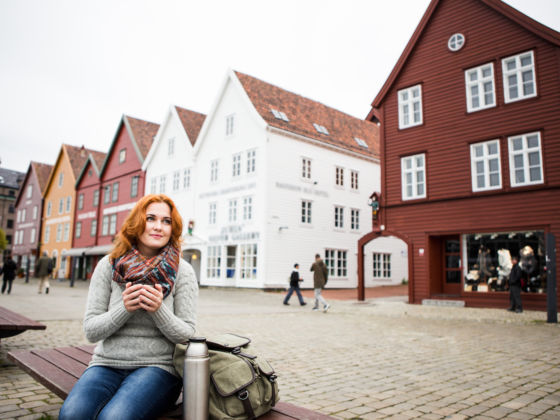Ask me any day of the week, and I’ll tell you that Bergen, Norway, is the most beautiful city on the planet. It’s a metropolis squeezed into a glacial valley; a Viking-age port with the humble roots of fishermen; it is the gateway to the country’s iconic fjords. It’s been said that there is a completeness to where the mountains meet the sea, and if that’s true, then Bergen lacks nothing.

Why Visiting Your Ancestral Home Feels so Familiar: It’s Literally in Your Bones.
When I first visited a year ago, I felt an intense sense of home. These streets I had never walked, these smells my nose shouldn’t recognize, this terra incognita — it all seemed strangely familiar and comforting. But how is that possible? I have Norwegian heritage, sure, but generations back. What makes a foreign place feel like home?
And then I found my answer. I was futzing around Bryggen, the UNESCO World Heritage Site, scoping out the 14th-century merchant houses along the harbor. I traced out zigzags on the back-alley walkways between the old white houses and worked my way toward the water, inching toward the Bryggens Museum — I had heard they had Bergen’s oldest excavations there, and I needed to see it for myself.
I’ve been thinking about this day ever since. The temporary exhibit, “From Where Do You Hail?” turned everything I thought I knew about genealogy on its head and added a dash of kismet. Am I from here?
Is geography is in our bones?
Your bones keep a record of your air and water intake. Your molars — at six years — mark the spot you’re living at that time, give or take a few hundred kilometers. Checkpoint one. Your wisdom teeth in adolescence mark a second spot. Checkpoint two. And the rest of your skeleton changes every five to 15 years, keeping its own record of isotype composition. Checkpoints three, four, five, etc.
How is this possible? Air and water are vastly different in different areas, and the amount and type of isotypes they contain vary from place to place. Not just countries — mile to mile, inland to sea, mountain to prairie. If you were living in Arizona when you were six and living in Washington when you were fourteen, scientists would be able to tell if they were to have a look.
So, yes, geography is in your bones. Your geography. If we carry place with us, of course we can harbor strange, inexplicable connections. Maybe my ancestors really did shape where I’m from and where I love. I carry my geography; do I also carry theirs?
You carry your mother’s mitochondrial DNA, otherwise known as mtDNA. And your mother’s mother’s. And her mother’s mother’s, and so on and so on until the chain literally ends at Mitochondrial Eve, your great-grandma about 10,000 generations ago. And your mother’s mtDNA carries a very specific set of mutations that are bound by geography and time. If you’re a male, you also have Y-DNA carried on your Y chromosome. Women, you don’t have Y chromosomes, so taking a DNA test won’t tell you much about your patrilineage.
This is how Ancestry.com “knows” where your spit is “from.” Each group of mutations is generally found in a specific part of the world, and each group is called a “haplogroup.” Each haplogroup is a branch point on the “mitochondrial phylogenetic tree,” each group forming at different times. You get a random selection from mom and a random selection from dad, meaning two siblings’ test results could come to remarkably different conclusions — but usually they’ll be pretty similar.
Group H is a common one in Western Europe, for example, and H is believed to have originated in Southwest Asia about 20,000 years ago.
You read that right. A common haplogroup in Western Europe originated in Southwest Asia. Your ancestors had to be from somewhere, too.
So, yes, you carry your “geographical DNA,” and your ancestors’ geographical DNA, which carries bits about where they’re probably from, sort of. What it actually tells you is where DNA like yours is most common. You’d have to look at your specific ancestors’ bones to really truly know where you’re “from.”
And you could do that, theoretically, because their skeletons carry their own geography. But doing so probably wouldn’t tell you that your ancestors are French or Canadian or Spanish. Doing so would probably show you they moved to Trondheim from Copenhagen. To Copenhagen from Warsaw. To Warsaw from Saratov. To Saratov from Tashkent.
They were all on the move, just like I am. Just like you are. Just like we all are.
And with that, they are from nowhere.
And you are from nowhere.
On my most recent trip to Bergen, I departed on the Fjord Line to Stavanger. I spent hours on the open bow watching the mountains turn into islands turn into sea, wondering which rocks my ancestors had encoded into their molars. I spent hours wondering why they left, wondering if they preferred the subtler beauty of cornfields.
Cornfields. That’s what’s encoded into my molars. As I’m crossing the Boknafjorden, I can’t help but note that this is just about the antithesis of the endless open plains of Iowa, my home that took me years to see as beautiful.
But now, I can’t blame the cornfields for my restlessness. We’re all from nowhere, and the desire for new places is like the desire for new lovers: a human one. You and I are a result of people on the move. Norwegian, Pakistani, South African, haplogroups H, F, L. It is the moving that is important.
We are born to be restless. To escape the past. To intensify the present. To outrun death. To follow in the footsteps of our ancestors. To move. We are born to travel until there is a completeness to ourselves.
Much like the completeness of where the mountains meet the sea.